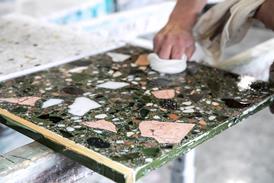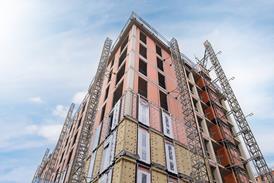In the broadcast, two hand-wringing Cassandras - Professor Alex Hardy of Newcastle University and Association of Metropolitan Authorities housing undersecretary Ted Cantle - were edited into a stranglehold over James Riley of the British Woodworking Federation and Sir Lawrie Barratt. Riley’s well-lunched face mouths its way through a menu of platitudes - “we at the BWF are by no means complacent...”. Sir Lawrie, breezily landing on site in the then trademark Barratt helicopter confidently predicts timber-frame would take 80% market share. The 1983 TV ad for Barratt of a screaming stunt helicopter is then repeatedly cut between Professor Hardy’s warnings about rot, making Sir Lawrie’s upbeat candour appear reckless. Barratt was left reeling, sales crashing from 16 500 to 6800.
Faced with sudden and intense buyer scepticism, timber-frame market share dived to 5%. The crisis led to extensive improvements in timber-frame site practice and drove out the cowboy element exposed in the broadcast. In 1992 the Building Research Establishment finally killed the canard about timber-frame’s life expectancy with “Moisture conditions in the walls of timber-frame houses”, and again in 1995 with evidence dating back to 1920. But the collective memory of the scare and conviction that the buying public is still running scared of negative associations has kept it marginalised.
Until now. TRADA, the timber-frame technical lobby, is quietly confident that 1999 will be the first year timber-frame across Great Britain will take a double-digit market share off masonry construction since the aftermath of the broadcast.
The door has been reopened partly for timber-frame by research done for Beazer Homes by Stirling University - independent of lobbying, for once - which shatters the myth that the buying public is as haunted by the TV broadcast as is the industry.
The sample analysed responses from 281 households in Scotland and Northern England. It was drawn from an equal mix of people who had visited Beazer sites but not bought and those who had bought. The most striking poll finding was that more than 9 out of 10 had no awareness of any publicity, positive or negative, associated with timber-frame.
Beazer wanted to investigate awareness by age, to check recall among those over 35 - at least 18 years old at the time of broadcast and therefore more likely to have taken notice of homebuying concerns. The researchers found that among the 35+ age group the number who were aware of any publicity, good or bad, did rise from 9.7% but to just 13.4%. Still only 1 in 10.
Respondents were then asked how their own home was constructed. Nearly four out of 10 - 38.5% - did not know. Stirling wrote: “There is no lasting stigma following World in Action. Awareness was higher among those aged 35 and over, but it was not significant overall. [We] believe Beazer are incorrect in their assumption that resistance is coming in some part from the consumer. The initial stigma perceived to exist externally has been proven to exist only in the minds of the industry.
“A self-fulfilling prophecy.”
Beazer has used the findings to assure staff whom such mythology had made apprehensive of its switch of 50% of its build programme over to timber-frame. High quality and speed of erection are cited as assisting in the group’s two-year drive to deliver all homes on time and with zero defects. Group sales and marketing manager Jill Galvin points out that Beazer is simply pro-quality and could be just as willing to use steel-frame in the future.
The Traditional Housing Bureau, the concrete blockmakers’ lobby based at the British Cement Association hq replied to Stirling’s findings with a MORI poll. When MORI asked 1996 respondents to pick a preferred construction method, only 13% had none and 52% wanted concrete block. Surprisingly though, 15% of respondents stated a preference for timber and brick, so with 28% either stating no preference or not knowing, MORI supports Stirling’s view that buyers have low recall of any publicity.
The THB is now calling on the timber lobby “to end its negative attitude”, meaning that it should not repeat Stirling’s conclusion that “whether the house is timber and brick or timber and block is largely irrelevant”. That will rankle deeply with timber-frame manufacturers that have spent 16 years hurting from what Beazer knowingly refers to as the blockmakers’ “negative tactics” that “culminated in the now infamous World in Action”. The public has forgotten the programme’s claims but it seems homebuilders won’t so easily forget who helped air them.
Source
Building Homes




















